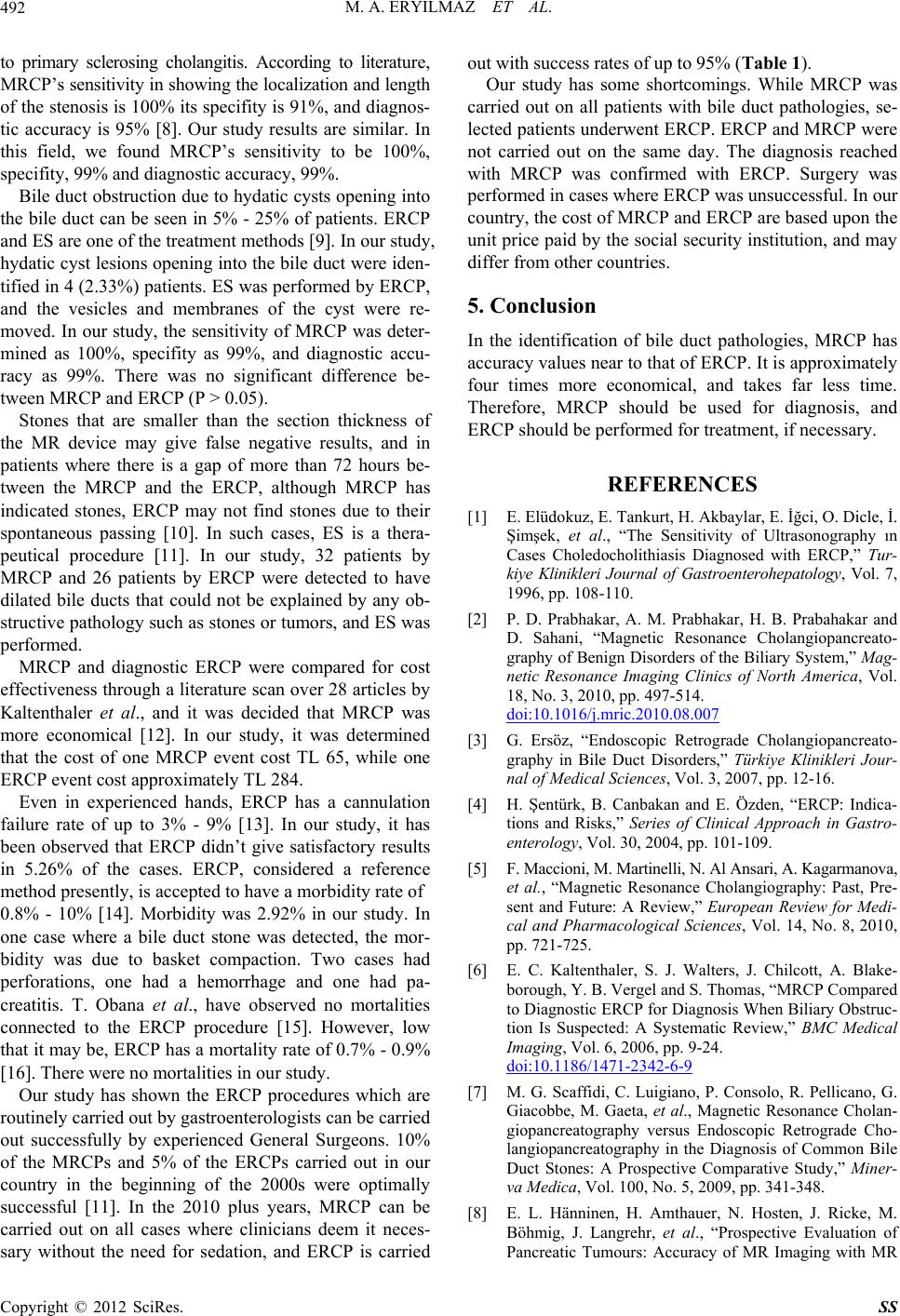
M. A. ERYILMAZ ET AL.
492
to primary sclerosing cholangitis. According to literature,
MRCP’s sensitivity in showing the localization and length
of the stenosis is 100% its specifity is 91%, and diagnos-
tic accuracy is 95% [8]. Our study results are similar. In
this field, we found MRCP’s sensitivity to be 100%,
specifity, 99% and diagnostic accuracy, 99%.
Bile duct obstruction due to hydatic cysts opening into
the bile duct can be seen in 5% - 25% of patients. ERCP
and ES are one of the treatment methods [9]. In our study,
hydatic cyst lesions opening into the bile duct were iden-
tified in 4 (2.33%) patients. ES was performed by ERCP,
and the vesicles and membranes of the cyst were re-
moved. In our study, the sensitivity of MRCP was deter-
mined as 100%, specifity as 99%, and diagnostic accu-
racy as 99%. There was no significant difference be-
tween MRCP and ERCP (P > 0.05).
Stones that are smaller than the section thickness of
the MR device may give false negative results, and in
patients where there is a gap of more than 72 hours be-
tween the MRCP and the ERCP, although MRCP has
indicated stones, ERCP may not find stones due to their
spontaneous passing [10]. In such cases, ES is a thera-
peutical procedure [11]. In our study, 32 patients by
MRCP and 26 patients by ERCP were detected to have
dilated bile ducts that could not be explained by any ob-
structive pathology such as stones or tumors, and ES was
performed.
MRCP and diagnostic ERCP were compared for cost
effectiveness through a literature scan over 28 articles by
Kaltenthaler et al., and it was decided that MRCP was
more economical [12]. In our study, it was determined
that the cost of one MRCP event cost TL 65, while one
ERCP event cost approximately TL 284.
Even in experienced hands, ERCP has a cannulation
failure rate of up to 3% - 9% [13]. In our study, it has
been observed that ERCP didn’t give satisfactory results
in 5.26% of the cases. ERCP, considered a reference
method presently, is accepted to have a morbidity rate of
0.8% - 10% [14]. Morbidity was 2.92% in our study. In
one case where a bile duct stone was detected, the mor-
bidity was due to basket compaction. Two cases had
perforations, one had a hemorrhage and one had pa-
creatitis. T. Obana et al., have observed no mortalities
connected to the ERCP procedure [15]. However, low
that it may be, ERCP has a mortality rate of 0.7% - 0.9%
[16]. There were no mortalities in our study.
Our study has shown the ERCP procedures which are
routinely carried out by gastroenterologists can be carried
out successfully by experienced General Surgeons. 10%
of the MRCPs and 5% of the ERCPs carried out in our
country in the beginning of the 2000s were optimally
successful [11]. In the 2010 plus years, MRCP can be
carried out on all cases where clinicians deem it neces-
sary without the need for sedation, and ERCP is carried
out with success rates of up to 95% (Table 1).
Our study has some shortcomings. While MRCP was
carried out on all patients with bile duct pathologies, se-
lected patients underwent ERCP. ERCP and MRCP were
not carried out on the same day. The diagnosis reached
with MRCP was confirmed with ERCP. Surgery was
performed in cases where ERCP was unsuccessful. In our
country, the cost of MRCP and ERCP are based upon the
unit price paid by the social security institution, and may
differ from other countries.
5. Conclusion
In the identification of bile duct pathologies, MRCP has
accuracy values near to that of ERCP. It is approximately
four times more economical, and takes far less time.
Therefore, MRCP should be used for diagnosis, and
ERCP should be performed for treatment, if necessary.
REFERENCES
[1] E. Elüdokuz, E. Tankurt, H. Akbaylar, E. İğci, O. Dicle, İ.
Şimşek, et al., “The Sensitivity of Ultrasonography ın
Cases Choledocholithiasis Diagnosed with ERCP,” Tur-
kiye Klinikleri Journal of Gastroenterohepatology, Vol. 7,
1996, pp. 108-110.
[2] P. D. Prabhakar, A. M. Prabhakar, H. B. Prabahakar and
D. Sahani, “Magnetic Resonance Cholangiopancreato-
graphy of Benign Disorders of the Biliary System,” Mag-
netic Resonance Imaging Clinics of North America, Vol.
18, No. 3, 2010, pp. 497-514.
doi:10.1016/j.mric.2010.08.007
[3] G. Ersöz, “Endoscopic Retrograde Cholangiopancreato-
graphy in Bile Duct Disorders,” Türkiye Klinikleri Jour-
nal of Medical Sciences, Vol. 3, 2007, pp. 12-16.
[4] H. Şentürk, B. Canbakan and E. Özden, “ERCP: Indica-
tions and Risks,” Series of Clinical Approach in Gastro-
enterology, Vol. 30, 2004, pp. 101-109.
[5] F. Maccioni, M. Martinelli, N. Al Ansari, A. Kagarmanova,
et al., “Magnetic Resonance Cholangiography: Past, Pre-
sent and Future: A Review,” European Review for Medi-
cal and Pharmacological Sciences, Vol. 14, No. 8, 2010,
pp. 721-725.
[6] E. C. Kaltenthaler, S. J. Walters, J. Chilcott, A. Blake-
borough, Y. B. Vergel and S. Thomas, “MRCP Compared
to Diagnostic ERCP for Diagnosis When Biliary Obstruc-
tion Is Suspected: A Systematic Review,” BMC Medical
Imaging, Vol. 6, 2006, pp. 9-24.
doi:10.1186/1471-2342-6-9
[7] M. G. Scaffidi, C. Luigiano, P. Consolo, R. Pellicano, G.
Giacobbe, M. Gaeta, et al., Magnetic Resonance Cholan-
giopancreatography versus Endoscopic Retrograde Cho-
langiopancreatography in the Diagnosis of Common Bile
Duct Stones: A Prospective Comparative Study,” Miner-
va Medica, Vol. 100, No. 5, 2009, pp. 341-348.
[8] E. L. Hänninen, H. Amthauer, N. Hosten, J. Ricke, M.
Böhmig, J. Langrehr, et al., “Prospective Evaluation of
Pancreatic Tumours: Accuracy of MR Imaging with MR
Copyright © 2012 SciRes. SS